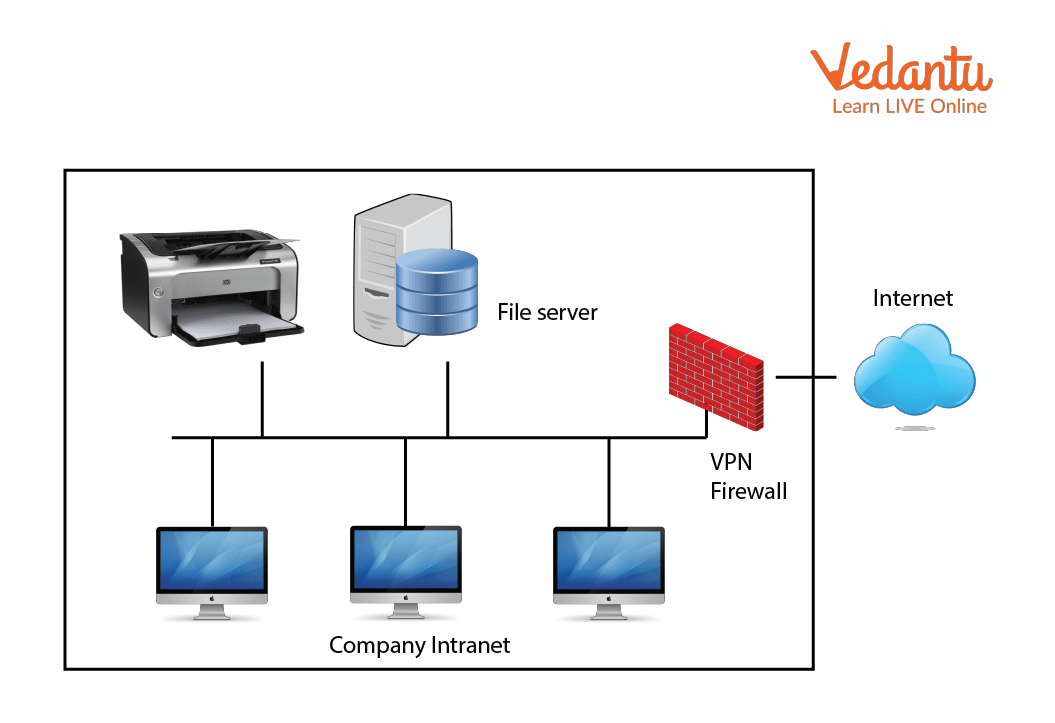




Intranet Meaning
An intranet is a private network used by a business. Its primary function is to aid employees in securely communicating, storing information, and collaborating. Social intranet features enable employees to create profiles and submit, like, comment on, and share posts on modern intranets.
It provides a secure platform for communicating information and sharing data with authorised users. The intranet can be used to make confidential information, databases, links, forms, and applications available to employees. In its most basic form, an intranet is built using technologies for local area networks (LANs) and wide area networks (WANs).

Company Intranet
Define Intranet
A private network of computers within a company that has its own server and firewall is referred to as an intranet. In addition, we can define an intranet as:
An intranet is a system where several PCs are networked together and connected. Intranet PCs are not accessible to people outside the intranet.
Each business or organisation typically has its own intranet network, which its customers, clients, and employees can access.
Every computer connected to the internet has a distinct IP address.
Additionally, each computer in an intranet has a unique IP address that serves as an additional form of identification.
Benefits of Intranet
Any organisation can benefit from an intranet's high efficiency and dependability. It is advantageous in every way, including cost-effectiveness, productivity, security, and many other areas. Some more benefits are:
Communication: An intranet allows for quick and inexpensive internal communication. Employees can interact via blogs, e-mail, or chat.
Time-Saving: On the intranet, information is exchanged instantly.
Collaboration: Information is distributed among employees as needed and can be accessed by authorised users, resulting in improved teamwork.
Cost Effective: Instead of printing them and giving out duplicate copies to each employee, employees can view the data and other documents using a browser, which undoubtedly lowers the cost.
Workforce Productivity: Data is always available and can be accessed via a company workstation. As a result, workers are able to work more effectively.
Security: Because information shared on the intranet can only be accessed within an organisation, there is almost no risk of theft.
Particular Users: Because an intranet only targets specific users within a company, one can be certain of his interaction partner.
Current Updates: All users immediately see any updates made to the information.

Intranet
Features of Intranet
The following are some of the features of an intranet:
The main component of the intranet system, document and content management, stores and manages business documents in the form of files, spreadsheets, PDFs, and more. Employees of the company can easily store, access, and share content and documents securely with other employees or managers using the intranet.
Every company has some sort of confidential information, including financial data, plans and policies, and personal information. Strong passwords on the intranet protect the company's sharing of sensitive data, preventing unauthorised users from accessing and misusing it.
Company intranets are beneficial to the employer when creating and deploying applications to support business decisions and operations throughout an internetworked enterprise.
Summary
Although some argue that intranets are no longer required, many think they are still important. But as the digital era advances, the intranets of today must be updated to support the digital transformation of every organisation. As a result, they must be user-friendly, engaging, and mobile-friendly.
Learning by Doing
Choose the correct answer:
1. Among these networks, which one is private?
Internet
Intranet
Extranet
MAN
2. ARPANET was the old name for the Internet. What is the official name of the ARPANET?
Advanced Research Projects Agency Network
Area Research Projects Agency Network
Advanced Research Projects Area Network
None of the above
Solved Questions
1. Give some disadvantages of Intranet.
Ans: Some disadvantages are:
Hidden costs and complexity can make setup expensive.
The firewall can be hacked by someone if it is not installed or functioning properly.
It is necessary to use passwords with high levels of security that outside users cannot guess.
There is constant concern about maintaining control over the intranet.
Duplication of documents can occasionally occur, confusing employees.
2. Write some examples of Intranet.
Ans: Some examples are:
Educational Intranet: These are typically found in schools, colleges, and other educational institutions. For instance, a school intranet aims to facilitate communication among teaching staff members and provide access to information about upcoming events like exam dates, school events, holidays, etc.
Real Estate Intranet: A real estate company's intranet gives its sales team access to all necessary templates, forms, and brochures that they might need to close a deal.
IT Sector Intranet: A lot of information needs to be shared with all of the employees at once in the IT sector. It might be connected to a task that must be finished within a certain time frame, such as guidelines, conditions, or rules that must be adhered to when working on a task.
3. "The largest computer network in the world, connecting millions of computers worldwide." This is what it means.
Network
Communication
Internet
Intranet
Ans: C) Internet
FAQs on Intranet
1. What distinguishes the internet from an intranet?
The distinction between the internet and an intranet is straightforward: while the internet is a public network that is not owned by any organisation, an intranet is privately owned and is not open to just anyone with access to the internet.
2. What are the various types of intranets?
Intranets are classified into three types: corporate intranets, departmental intranets, and individual user intranets. The most common type is corporate intranets, which are used by the entire company.
3. Who created the intranet?
There was an intranet before there was the internet. It should be no surprise that the Department of Defense Advanced Research Projects Agency created the first intranet.























